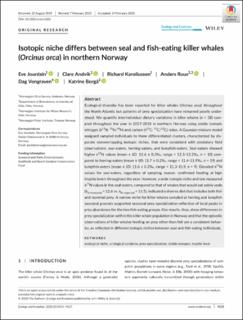| dc.description.abstract | Ecological diversity has been reported for killer whales (Orcinus orca) throughout the North Atlantic but patterns of prey specialization have remained poorly understood. We quantify interindividual dietary variations in killer whales (n = 38) sampled throughout the year in 2017–2018 in northern Norway using stable isotopic nitrogen (δ15N: 15N/14N) and carbon (δ13C: 13C/12C) ratios. A Gaussian mixture model assigned sampled individuals to three differentiated clusters, characterized by disparate nonoverlapping isotopic niches, that were consistent with predatory field observations: seal‐eaters, herring‐eaters, and lumpfish‐eaters. Seal‐eaters showed higher δ15N values (mean ± SD: 12.6 ± 0.3‰, range = 12.3–13.2‰, n = 10) compared to herring‐eaters (mean ± SD: 11.7 ± 0.2‰, range = 11.4–11.9‰, n = 19) and lumpfish‐eaters (mean ± SD: 11.6 ± 0.2‰, range = 11.3–11.9, n = 9). Elevated δ15N values for seal‐eaters, regardless of sampling season, confirmed feeding at high trophic levels throughout the year. However, a wide isotopic niche and low measured δ15N values in the seal‐eaters, compared to that of whales that would eat solely seals (δN‐measured = 12.6 vs. δN‐expected = 15.5), indicated a diverse diet that includes both fish and mammal prey. A narrow niche for killer whales sampled at herring and lumpfish seasonal grounds supported seasonal prey specialization reflective of local peaks in prey abundance for the two fish‐eating groups. Our results, thus, show differences in prey specialization within this killer whale population in Norway and that the episodic observations of killer whales feeding on prey other than fish are a consistent behavior, as reflected in different isotopic niches between seal and fish‐eating individuals. | en_US |

